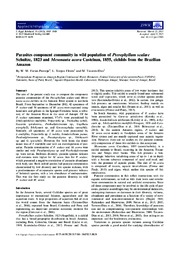Parasites component community in wild population of Pterophyllum scalare Schultze, 1823 and Mesonauta acora Castelnau, 1855, cichlids from the Brazilian Amazon.
Parasites component community in wild population of Pterophyllum scalare Schultze, 1823 and Mesonauta acora Castelnau, 1855, cichlids from the Brazilian Amazon.
Autoria: PANTOJA, W. M. F.; FLORES, L. V.; TAVARES-DIAS, M.
Resumo: The aim of the present study was to compare the component parasite communities of the Pterophyllum scalare and Mesonauta acoracichlids in the Amazon River system in northern Brazil. From September to December 2012, 42 specimens of P. scalareand 38 specimens of M. acorawere captured using hand nets and gillnets in the Igarape Fortaleza basin, a tributary of the Amazon River in the state of Amapa. Of the P. scalarespecimens examined, 97.6% were parasitized by Ichthyophthirius multifiliis, Tripartiellasp., Trichodina nobilis, Gussevia spiralocirra, Posthodiplostomum sp., Capillaria pterophylli, Ichthyouris sp. and Gorytocephalus spectabilis. Similarly, all specimens of M. acorawere parasitized by I. multifiliis, Tripartiellasp,T. nobilis, Sciadicleithrum joanae, Posthodiplostomum sp., Pseudoproleptus sp., Ichthyouris sp. and G. spectabilis. However, for both hosts the dominance was of I. multifiliisand with an overdispersion of parasites. Parasite communities of P. scalare and M. acorawere similar and only Pseudoproleptussp. and Posthodiplostomum sp. were larvae. Brillouin diversity, parasite species richness and evenness were higher forM. acorathan for P. scalare, which presented a negative correlation of parasite abundance with body size. Both cichlid species had parasite communities characterized by low diversity and low species richness, with a predominance of ectoparasite species and greatest richness of helminth species, with a low abundance of endoparasites. This was the first study on the parasite diversity in wild P. scalareandM. acora.
Ano de publicação: 2015
Tipo de publicação: Artigo de periódico
Unidade: Embrapa Amapa
Palavras-chave: Parasite animal, Parasito animal
Observações
1 - Por padrão são exibidas publicações dos últimos 20 anos. Para encontrar publicações mais antigas, configure o filtro ano de publicação, colocando o ano a partir do qual você deseja encontrar publicações. O filtro está na coluna da esquerda na busca acima.
2 - Para ler algumas publicações da Embrapa (apenas as que estão em formato ePub), é necessário ter, no celular ou computador, um desses softwares gratuitos. Sistemas Android: Google Play Livros; IOS: iBooks; Windows e Linux: software Calibre.
Acesse outras publicações
Acesse a Base de Dados da Pesquisa Agropecuária (BDPA) para consultar o acervo completo das bibliotecas da Embrapa.

